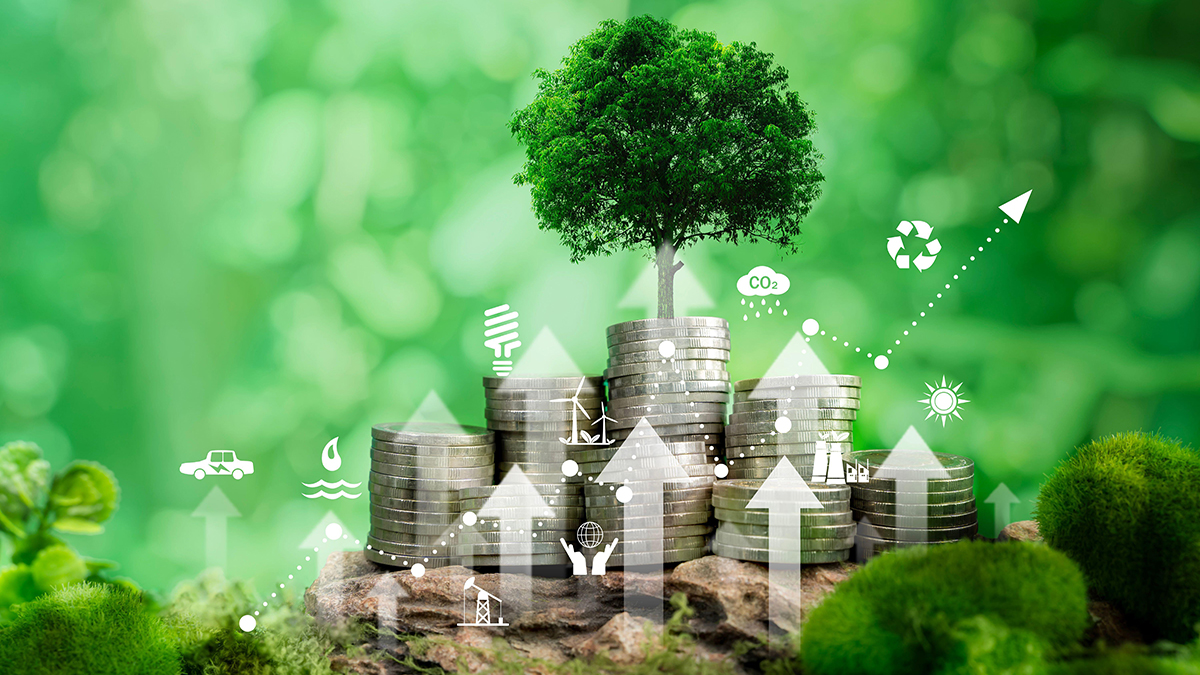How to build a climate finance ecosystem
‘We need an international financial ecosystem that is fit for purpose. This should promote differing types of finance, instruments and risk appetite,’ British International Investment’s Amal-Lee Amin says
Managing director and head of climate, diversity and advisory at the UK’s development finance institution outlines how DFIs are innovating to fund the transition to net zero
Development finance institutions (DFIs) may be small relative to other parts of the finance community, but this enables an agile response to climate investing, according to the managing director and head of climate, diversity and advisory at British International Investment (BII), Amal-Lee Amin.
DFIs invest in private sector businesses, banks and projects in less economically developed countries to bring about positive economic, social and environmental change. They are smaller, for example, than multilateral development banks (MDBs) and Amin has experience of both. Previously she was chief of climate change at the Inter-American Development Bank.
Given the scale of climate finance needed by developing countries, MDBs are attracting a lot of attention about how they can innovate to take more risk to mobilise private capital, while DFIs, which typically take more risk, operate more “under the radar”, Amin says in an interview with Insurance Day..
“In the climate finance ecosystem, MDBs are like supertankers while DFIs are the speedboats,” she adds.
An “ecosystem” that maximises differing areas of comparative advantage and fosters innovation is needed if commercial capital is to be unlocked at pace and scale. Focusing on this, Amin says, rather than on a top-down financial architecture that may overlook the influence of different actors, including DFIs, is key.
For example, the £100m ($129.4m) mobilisation facility announced by Britain’s prime minister, Keir Starmer, in September, aims to unlock private investment in emerging economies, focusing on climate and sustainability. Within weeks of that announcement, BII had partnered with Mercer, the US consulting subsidiary of Marsh McLennan, to open a climate finance mobilisation call for proposals for private investors’ designs for products that address the gap between the risk appetite and return thresholds of institutional investors.
“In the climate finance ecosystem, DFIs like ourselves can be a trailblazer, partnering with those who are also innovating in the private sector,” Amin says. “That’s definitely the case with the mobilisation facility and in a relatively short time frame we’ve started to do some really innovative mobilisation transactions.”
To illustrate the urgency of this effort in the global context, Amin points to Raising ambition and accelerating delivery of climate finance, the third report of the independent High Level Expert Group on Climate Finance, of which she is a member. The scale of investment needs in emerging markets and developing countries (excluding China) are estimated at $2.4trn a year by 2030, with more than half of this being mobilised from domestic sources and around $1trn a year of external finance needed.
Investible opportunities
BII has been building “investable opportunities” for commercial investors, Amin says, such as the platform it “created from scratch” in 2018 for Ayana Renewable Power in India. Amin says: “Rather than put equity into a single project, we put it into a platform and worked alongside private sector sponsors to help build out the business. The financial capital is important, of course, but so too is human capital, and through these platforms we not only provide finance but build the dedicated expertise that is needed to scale in our markets.”
In February this year, ONGC NTPC Green Private Ltd signed a share purchase agreement with BII, the National Investment and Infrastructure Fund and Eversource Capital to acquire a 100% equity stake in Ayana Renewable for an enterprise value of Rupee195bn ($2.3bn). Ayana has about 4.1 gigawatts of operational and under-construction assets.
This platform is a perfect example, Amin says, of how to “reinforce the circle” of a developing country’s Nationally Determined Contribution (NDC) under the Paris Agreement and domestic resource mobilisation. “As the Indian government increases its own capital contribution to renewables, it recognises the importance of policy and regulation for these investments,” she says. Amin points out BII does not work directly with governments, but its collaboration with domestic financial institutions in, for example, India, is “equally important” to ensure countries “maintain ambition” with their NDCs.
“Ensuring there is a pipeline of investable opportunities is critical and the platforms we work on are an important way of doing that, but we also need governments to put in place the right enabling context because it’s the right policies and regulations that will provide the investor certainty needed to unlock capital”
Amal-Lee Amin
British International Investment
Another company BII is supporting is Globeleq, Africa’s leading independent power producer. BII took control of the company (70%) in 2015 alongside Norfund (30%). Since then, Globeleq has almost doubled in size, adding nine assets to its portfolio, of which eight are renewables.
A third example is Gridworks, a development and investment platform principally targeting equity investments in transmission, distribution and off-grid electricity in Africa. Building networks, including “mini-grids”, in the continent is “critical”, Amin says, because the main challenge of rolling out renewable energy projects is not having existing grid infrastructure to absorb new electricity capacity.
A recent report by the Overseas Development Institute, a global affairs think tank, highlights the value of BII’s approach to investing in new ventures and platforms like these for building out investible opportunities.
Amin highlights investors that signed up to the Glasgow Financial Alliance for Net Zero, a group that formed during COP26, are committed to having net-zero portfolios, which requires them to invest in assets that are consistent with that goal. She says: “To a large extent what we’re seeing now – and some of the banks in the UK are starting to signal this – is they can only move as fast as government policy enables the investable opportunities that are consistent with net zero. In other words, they are saying their ability to deliver will depend on the level of government ambition.”
The UK’s updated NDC for 2035, announced this January, commits to an 81% reduction in greenhouse gas emissions compared with 1990 levels, a target deemed 1.5°C-aligned and informed by the COP28 Global Stocktake. Such ambition, Amin says, is “exactly what the financial sector wants to see”. Such a commitment, backed up with relevant policy and pricing signals, provides the long-term investment security, she adds.
BII has set itself the goal of facilitating investments that are aligned with the Paris Agreement; in this way it is contributing towards delivering countries’ NDCs in those markets where it invests. To further achieve this, BII also helps strengthen domestic financial sectors. This ranges from investing equity in banks and providing green lines of credit, as well as capacity building, such as through its technical assistance facility FSG Plus, which works with financial service providers in south Asia and Africa to catalyse investment in low-carbon, climate-resilient projects and promote inclusive climate finance.
Both sides of the coin
Increasingly, commercial investors are realising they must not limit themselves to only “one side of the coin”, Amin stresses, by assuming the transition to net zero is solely an exercise in “risk and disclosure”. The other side is opportunity and investment, which BII helps investors explore; for example, through its venture capital vertical. BII is increasingly seeing promising early-stage companies that are harnessing artificial intelligence to deliver climatetech solutions for increasing adaptation and resilience of smallholder farmers in Africa and south Asia.
“BII is probably one of the unique DFIs in that we work with venture capital, which an MDB might consider as too risky,” Amin says. “It shows there is no ‘one size fits all’ in climate finance, that we need different types of instruments and risk appetites,” she adds.
There has been a perception among re/insurers that their role in climate finance is limited to risk transfer, but this is changing, Amin says. “We’re talking to many of the insurers and we really welcome the fact they’re wanting to come into the investment opportunity side more,” she adds. BII last year launched an innovative fund with investment manager Blue Orchard, a member of the Schroders Group, which has so far invested in financial services companies in various countries, including Ghana, India and Vietnam.
“We’re now starting to think much more intentionally about how we mobilise the institutional investors, who obviously include insurers. I think everyone’s been focused heavily on pension funds, but the insurance sector itself is now starting to recognise the potential opportunities,” Amin says.
“We’re seeing major asset managers such as BlackRock engaging with the Insurance Development Forum to co-create a fund to mobilise insurers capital for resilient infrastructure. That’s definitely the direction of travel for BII in terms of how we partner to increasingly mobilise these really big pools of capital,” she adds.
This will involve refinancing renewable energy assets on BII’s balance sheets as well as the books of domestic banks to help governments and investors meet their decarbonisation targets. “There’s been a big push for the development finance community to ‘originate to distribute’, which is what we’ve been doing to a large extent with our platforms,” Amin says.
As BII engages more with DFIs, Amin continues, there will also be a focus on regulatory challenges to mobilising institutional capital that may be presented by Basel III and Solvency II.
These discussions will be a feature of planning for the Baku-to-Belém Roadmap that will set out the steps to be taken towards reaching the $1.3trn/year of international finance flowing into developing countries by 2035. “Governments are going to have to look at the whole ecosystem,” Amin says, “including the international regulatory agenda.”
Effective partnerships with “like-minded institutions” are crucial to this roadmap and there are number of UK initiatives where BII could be “the main delivery partner”, Amin says, highlighting the UK-led Global Clean Power Alliance (GCPA). COP30 host, Brazil, will co-lead the GCPA’s first mission on finance, which Amin says sends a strong message to countries at the climate talks of the need to work together to deliver the clean energy transformation needed.
Amin says: “Ensuring there is a pipeline of investable opportunities is critical and the platforms we work on are an important way of doing that, but we also need governments to put in place the right enabling context because it’s the right policies and regulations that will provide the investor certainty needed to unlock capital. The scale of tackling the climate crisis means we need to work in a more systemic way.”
An “ideal” situation at COP30, Amin says, will be recognition the transition to net zero is under way, climate finance is flowing and more ambitious NDCs are valued as drivers of investment and economic growth.
She concludes: “There has been negativity in recent years that climate ambition is anti-growth when, actually, when you look at the clean technologies that are becoming available and the socio-economic opportunities they bring, the opposite is true.”



